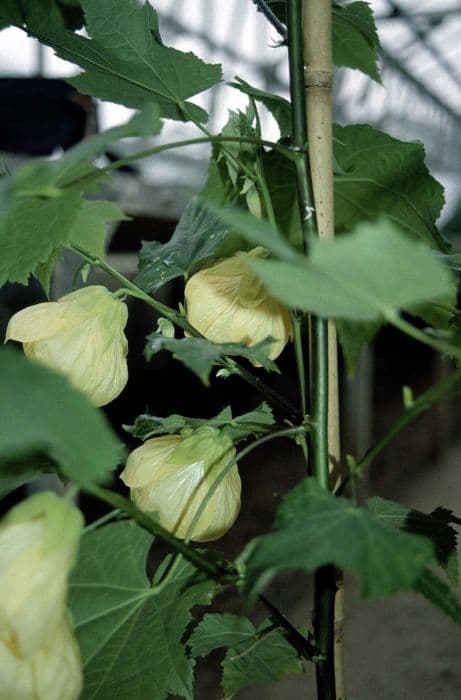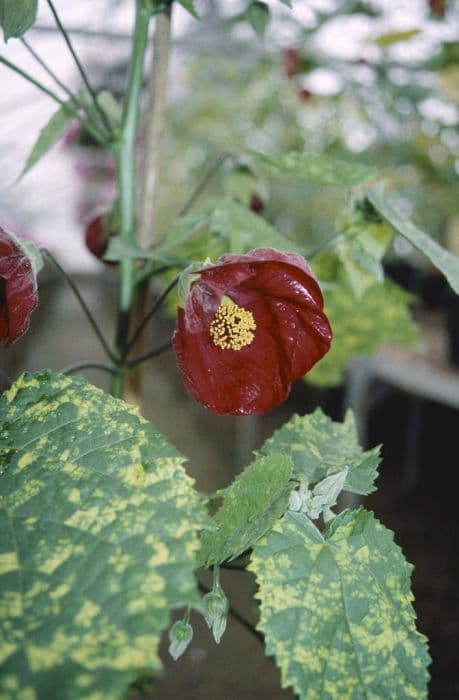Japanese lantern Hibiscus schizopetalus

ABOUT
The Japanese lantern, as Hibiscus schizopetalus is commonly known, is a very distinctive and ornamental plant that is instantly recognizable due to its unique floral display. The flowers of this plant are its most striking feature, characterized by their deeply lobed, fringed petals which gracefully hang down like exotic chandeliers. Typically, the blossoms are a vibrant shade of red or pink, creating a bold contrast against the green foliage. The petals are finely dissected, almost thread-like, lending the blooms an intricate, lace-like appearance. Apart from the mesmerizing flowers, the Japanese lantern also bears attractive foliage. The leaves are glossy and have a deep green color, with a slightly toothed edge, giving the plant an overall lush and tropical aspect. The buds and stems often display a reddish tint, adding to the visual interest of the plant. This particular hibiscus is a favorite among gardeners and plant enthusiasts for its distinctive, pendant flowers that invoke a sense of the dramatic in any garden setting.
About this plant
 Names
NamesFamily
Malvaceae
Synonyms
Japanese Lantern, Fringed Hibiscus, Coral Hibiscus, Spider Hibiscus, Skeleton Hibiscus, Chinese Lantern
Common names
Hibiscus schizopetalus.
 Toxicity
ToxicityTo humans
The Japanese Lantern is not considered toxic to humans. Thus, ingestion of the Hibiscus schizopetalus commonly known as Japanese Lantern does not typically cause poisoning or toxic symptoms in humans.
To pets
Japanese Lantern is generally considered non-toxic to pets, including dogs and cats. There are no well-documented cases of poisoning from ingesting Hibiscus schizopetalus in pets. However, as with any non-food plant, ingestion of large amounts may cause mild gastrointestinal upset. Symptoms could include vomiting, diarrhea, or a lack of appetite, but such instances are uncommon.
 Characteristics
CharacteristicsLife cycle
Perennials
Foliage type
Evergreen
Color of leaves
Green
Flower color
Red
Height
8-12 feet (2.4-3.7 meters)
Spread
4-6 feet (1.2-1.8 meters)
Plant type
Shrub
Hardiness zones
9
Native area
Africa
Benefits
 General Benefits
General Benefits- Aesthetic Appeal: The Hibiscus schizopetalus, commonly known as the Coral Hibiscus, has unique, deeply lobed, pendulous flowers that add an exotic touch to gardens and landscapes.
- Attracts Pollinators: Its vibrant flowers attract butterflies and hummingbirds, which play a role in pollination and add dynamism to the garden ecosystem.
- Shade Tolerance: While it prefers full sun, the Coral Hibiscus can tolerate partial shade, making it versatile for planting in various garden spaces.
- Tropical Ambiance: Its tropical appearance can be used to create a theme or accentuate a style in gardens, offering a visual escape to the tropics.
- Easy Propagation: The plant can be easily propagated from cuttings, making it simple for gardeners to create more plants for use in different areas or to share with friends.
- Fast Growing: Coral Hibiscus is a fast-growing plant, allowing gardeners to achieve a mature and established look in their gardens relatively quickly.
 Medical Properties
Medical Properties- Antioxidant: Hibiscus schizopetalus may contain compounds with antioxidant properties that help in protecting cells from damage by free radicals.
- Anti-inflammatory: Some studies suggest the plant has anti-inflammatory effects that might be useful in reducing inflammation in the body.
- Antipyretic: Traditionally, it has been used to reduce fever, although scientific evidence for this use is limited.
- Antibacterial: There is some evidence that suggests Hibiscus schizopetalus might have antibacterial properties, potentially useful in fighting bacterial infections.
- Antihypertensive: Hibiscus species have been studied for their potential in lowering blood pressure, though specific evidence for Hibiscus schizopetalus is scarce.
 Air-purifying Qualities
Air-purifying QualitiesThis plant is not specifically known for air purifying qualities.
 Other Uses
Other Uses- As a natural dye: The flowers of the Coral Hibiscus can be used to create a natural dye for fabrics, offering a range of pink and purple hues.
- Culinary decoration: Its unique and striking flowers can be used as an edible decoration on cakes and desserts, adding an exotic touch to culinary presentations.
- In aquascaping: Coral Hibiscus can be grown near water features, adding a tropical flair to aquascaping design in ponds and aquariums.
- As an art medium: Dried parts of the Coral Hibiscus plant can be used in crafting for creating floral arrangements, or even in potpourri mixes.
- For educational purposes: This plant is sometimes used in schools and botanical studies to teach students about unique floral structures due to its intricate flower form.
- As a photography subject: The Coral Hibiscus, with its pendulous flowers, serves as an interesting subject for photographers specializing in botanical and nature imagery.
- In ornamental fish ponds: The shade provided by the Coral Hibiscus plant can be beneficial for fish that prefer cooler water temperatures in ornamental ponds.
- In floatation devices: Historically, the buoyant nature of Hibiscus wood has been used to create floatation devices for fishing nets.
- In horticultural therapy: Gardening with the Coral Hibiscus can be a therapeutic activity used to help improve mental health and well-being.
- Hair accessory: In some cultures, the showy flowers of the Coral Hibiscus are worn in the hair for aesthetic purposes during traditional dances and ceremonies.
Interesting Facts
 Feng Shui
Feng ShuiThe Coral Hibiscus is not used in Feng Shui practice.
 Zodiac Sign Compitability
Zodiac Sign CompitabilityThe Coral Hibiscus is not used in astrology practice.
 Plant Symbolism
Plant Symbolism- Exotic beauty: Hibiscus schizopetalus, commonly known as Coral Hibiscus, is often associated with exotic beauty due to its unique and intricate flower structure.
- Delicate femininity: The Coral Hibiscus, with its graceful and delicate looking flowers, symbolizes feminine beauty and softness.
- Rarity: Since this is a less common species of hibiscus, it can symbolize something rare and valuable.
- Purity: Like many flowers, the Coral Hibiscus can also be associated with purity due to its bright and clean appearance.
- Welcoming: In many cultures, hibiscus flowers are used to indicate hospitality and warm welcome, making them appropriate for use in greeting spaces.
 Water
WaterThe Coral Hibiscus should be watered deeply when the top inch of the soil feels dry to the touch; this typically means watering once every few days during active growth seasons (spring and summer) and reducing to once a week during the dormant season (fall and winter). Ideally, provide one to two gallons of water per watering session, ensuring consistent moisture but not over-saturating the soil. During the hotter months, be vigilant to prevent the soil from completely drying out, as prolonged dryness can damage the plant.
 Light
LightThe Coral Hibiscus thrives in full sunlight to partial shade, with at least six hours of direct sunlight per day being optimal for flower production and growth. The best spot for this plant is an east or west-facing location that receives morning or afternoon sun with some dappled shade to protect it from the intense midday sun.
 Temperature
TemperatureThe Coral Hibiscus prefers a warm climate with temperatures between 60°F and 90°F. It can survive minimum temperatures of around 40°F, but frost or prolonged exposure to cold can damage the plant. The ideal temperature range for this hibiscus is between 70°F and 85°F, ensuring vibrant growth and blooming.
 Pruning
PruningPrune the Coral Hibiscus to maintain its shape, remove dead or diseased branches, and encourage bushier growth and more blooms. The best time for pruning is early spring, before the new growth begins. Prune as often as needed to remove old flowers and seed pods, which encourages new flower production.
 Cleaning
CleaningAs needed
 Soil
SoilCoral Hibiscus requires well-draining soil rich in organic matter with a pH of about 6.5 to 6.8. A good mix is two parts peat moss, one part loam, and one part sand or perlite to ensure proper drainage and aeration. Regularly check the pH to maintain slight acidity.
 Repotting
RepottingCoral Hibiscus should be repotted every 2 to 3 years or when the root system outgrows the pot. Choose a container that is slightly larger than the previous one to allow for continued growth.
 Humidity & Misting
Humidity & MistingCoral Hibiscus thrives in high humidity environments, ideally between 60% to 80%. If the air is too dry, the leaves may become crisp and lose their lush appearance.
 Suitable locations
Suitable locationsIndoor
Place Coral Hibiscus in bright, indirect light indoors.
Outdoor
Grow Coral Hibiscus in partial shade outside.
Hardiness zone
9-11 USDA
 Life cycle
Life cycleThe life cycle of the Japanese Lantern (Hibiscus schizopetalus) begins with seed germination, where a seed sprouts into a seedling under appropriate temperature, light, and moisture conditions. The seedling then grows into a juvenile plant, developing a root system, stem, and leaves. As the plant matures, it enters the vegetative stage, where it grows larger and produces more foliage, preparing for reproduction. The reproductive stage follows, where the Japanese Lantern produces distinctive, pendulous, and fringed flowers that attract pollinators for sexual reproduction. After pollination and fertilization, the plant forms seed pods that eventually dry and release seeds, completing the reproductive cycle. The plant will continue this process, experiencing multiple reproductive cycles throughout its perennial life span.
 Propogation
PropogationPropogation time
Spring to summer
The Japanese Lantern, or Hibiscus schizopetalus, is commonly propagated through stem cuttings, a method favored for its simplicity and effectiveness. To propagate with this technique, healthy, disease-free cuttings around 4 to 6 inches (10 to 15 centimeters) long with several leaf nodes are taken from the parent plant. These cuttings are typically taken in the spring or early summer when the plant is actively growing. The lower leaves are removed, and the cut base is often treated with a rooting hormone to encourage root development. Then, the cutting is planted in a well-draining soil mix, and the environment is kept humid, for instance, by covering the cutting with a plastic bag, until roots have established, which usually takes several weeks. After the roots are formed, the cutting can be transplanted into a larger pot or directly into the garden, depending on the local climate.








![Rose of Sharon [Lavender Chiffon]](/_next/image?url=https%3A%2F%2Fplants-admin.emdemapps.com%2Fimages%2Fplants%2F%2Fimages%2F604b616c0ddec.png&w=640&q=75)
